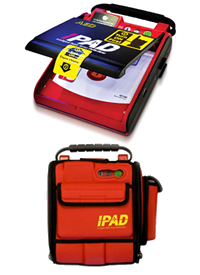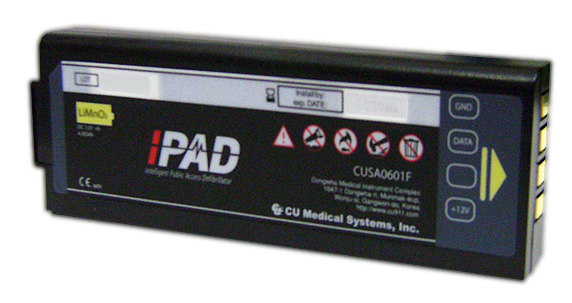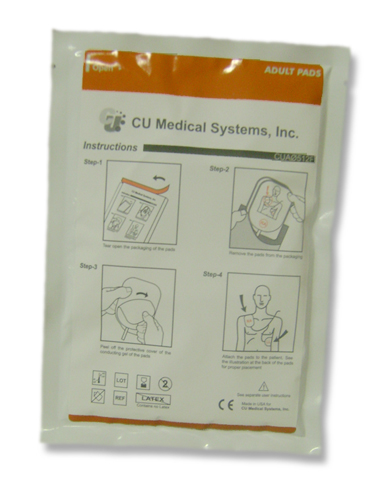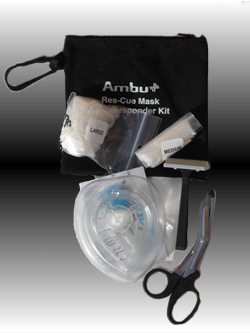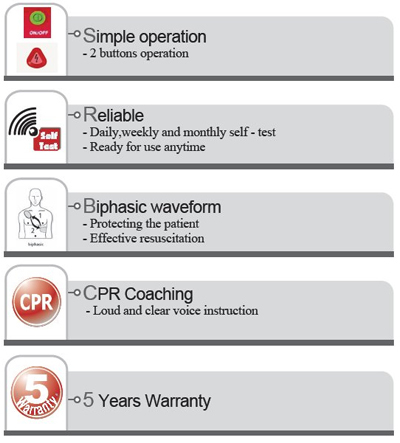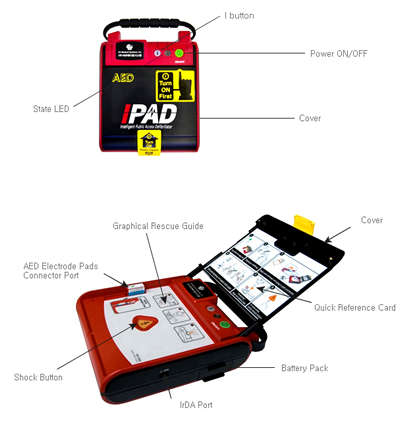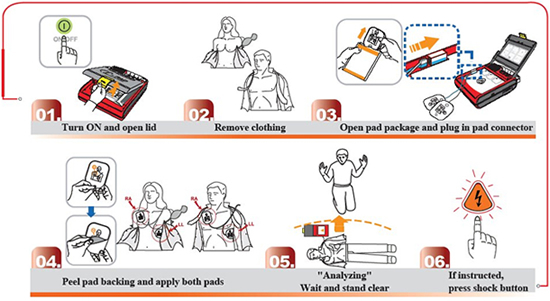| Physical |
|
|
ECG Analysis System |
|
| Size |
2.75 in high X 8.66 in wide X 10.23 in deep
(70mm high X 220 mm wide X 260 mm deep) |
|
Function |
Determines the impedance of the patient and evaluates the ECG of the patient to determine whether it is shockable or non shockable |
| Weight |
Approximately 4.84 lbs (2.2 kg)
with battery pack installed |
|
Impedance Range |
25Ω to 175Ω |
| Environmental |
|
|
Shockable Rhythms |
Ventricular Fibrillation or Fast Ventricular Tachycardia |
| Operating Conditions |
Temperature: 32˚F to 110˚;F (0˚C to 43 ˚C)
Humidity: 5 % to 95 % (non-condensing) |
|
Non Shockable Rhythms |
ECG rhythms other than Ventricular Fibrillation or Fast Ventricular Tachycardia |
| Storage Conditions |
Temperature: 32˚F to 110 ˚F (0 ˚C to 43 ˚C)
Humidity: 5 % to 95 % (non-condensing) |
|
Sensitivity & Specificity: |
Meets AAMI DF39 guidelines |
| Shock/Drop/Abuse Tolerance |
Meets IEC 60601-1 clause 21 (Mechanical Strength) |
|
Controls, Indicators, and Prompts |
|
| Vibration |
Meets EN1789 random and swept sine, road ambulance specification in operating and standby states. |
|
Controls |
Power On/Off Button,
i-Button,
Shock Button |
| Sealing |
IEC 60529: IP54 |
|
Indicators |
State LED, Graphical Rescue Guide LED |
| ESD |
Meets IEC 61000-4-2:2001 |
|
Audio Speaker |
Provides voice prompts |
| EMI (Radiated) |
Meets IEC 60601-1-2 limits, method EN 55011:1998+ A1:1999 +A2:2002, Group 1, Class B |
|
Beeper |
Provides various audible indications |
| EMI (Immunity) |
Meets IEC 60601-1-2 limits, method EN 61000-4-3:
2001 Level 3 (10V/m 80MHz to 2500MHz) |
|
Low Battery Detection |
Automatic during daily testing and Power ON and runtime testing |
| Defibrillator |
|
|
Low Battery Indicator |
State LED and Voice Prompt |
| Operating Mode |
Semi-automated |
|
Prompts |
Voice prompts guide the user throughout a rescue operation |
| Waveform |
e-cube biphasic (Truncated exponential type); impedance compensated |
|
Self-Tests |
|
| Energy |
200 Joules nominal into a 50Ω load |
|
Automatic |
* Power On Self-Test / Run Time Self-Test
* daily / weekly/ monthly |
| Shock Energy Accuracy |
Within ±3% (150J into 50Ω) |
|
User Initiated |
Battery Insertion Test |
| Charge Control |
Automatic by Software (Arrhythmia Detection System and Charging Control) |
|
Battery Pack |
|
| Charge time from “Shock Advised” |
< 14 seconds, typical |
|
Battery Type |
12 Volt DC, 4.2 Ah, lithium manganese dioxide, disposable long-life primary cell. |
| Shock to Shock cycle time |
< 15 seconds, typical, including analysis |
|
Capacity |
Minimum 200 shocks or 4 hours of operating time. |
| Charge complete indicator |
* Text prompt (PRESS THE FLASHING ORANGE BUTTON, NOW)
* flashing backlight of SHOCK button
* beep from the beeper |
|
Temperature Range |
-40 °F to 140 °F (-40 °C to 60 °C) |
| Disarm |
Once charged, the NF1200 disarms if:
* Patient’s heart rhythm changes to non-shockable rhythm, or
* The SHOCK button is not pressed within 15 seconds after the NF1200 is armed, or
* The ON/OFF button is pressed to turn OFF the NF1200, or
* The defibrillator pads are removed from the patient or the pads connector is disconnected from the NF1200 |
|
Defibrillator Pads (CUA0512F) |
|
| Defibrillator, continued |
|
|
Type |
self-adhesive, disposable, non-polarized defibrillation pads |
| Shock Delivery |
Shock is delivered if the SHOCK button is pressed while the NF1200 is armed. |
|
Adult Pads |
Defibrillation pads for patients 8 years of age and older or 55 lbs. (25 kg) and over. |
| Shock Delivery Vector |
Via adult defibrillator pads in the anterior-anterior (Lead II) position or via Reduced-energy pediatric pads in the anterior-posterior position. |
|
Surface Area |
Adult : 110cm2 each |
| Patient Isolation |
Type BF |
|
Cable Length |
1.5m |
| ECG Acquisition |
|
|
Data Recording and Transmission |
|
| Acquired ECG Lead |
Lead II |
|
Infrared |
Wireless transmission of event data to PC through IrDA port. |
| Frequency Response |
1 Hz to 30 Hz EMS Mode
0.3 Hz to 40 Hz Monitoring Mode |
|
Data Stored |
First 40 minutes of ECG and the entire incident’s events and analysis decisions. |


![]()















